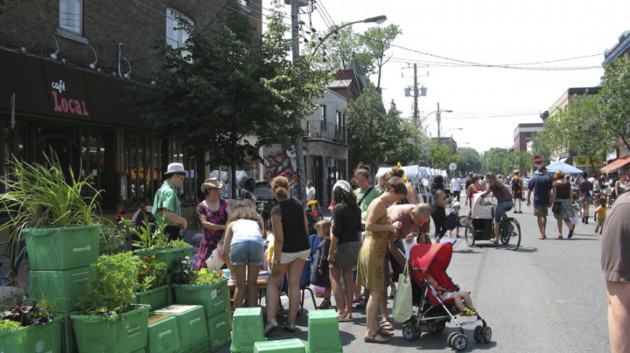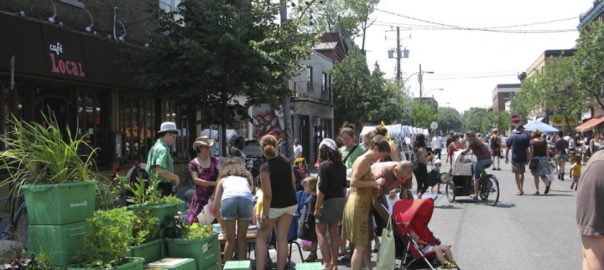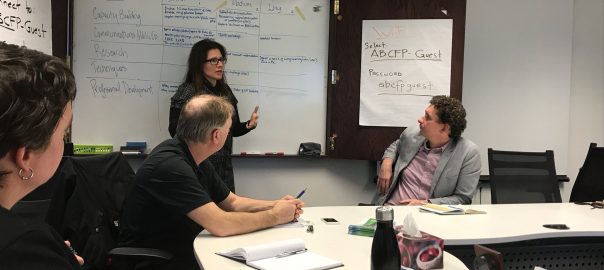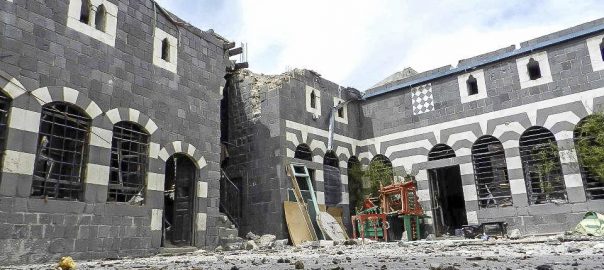Jane Jacobs said: ‘Cities have the capability of providing something for everybody, only because, and only when, they are created by everybody.’ To embrace this idea that everyone has to be involved in creating cities is to recognize the vitality of neighborhoods as the scale at which most people relate to the city in their daily lives. Neighborhoods are, in effect, the places where we live and where we tend to spend most of our time, even if much of that is within our private dwellings. They are the places we know best, where we come home to, and where, as the urbanist Lewis Mumford (1954: 269) said, we can ‘recover the sense of intimacy and innerness that has been disrupted by the increased scale of the city’.
Although Mumford and Jacobs sparred often, their thinking can be seen to converge on the question of how neighborhoods matter for city-building. Urban residents are concerned with their neighborhoods because what happens at this geographic scale affects their everyday experience and quality of life. People tend to be invested in and relate to the ‘local’ scale of the neighborhood in a more direct way than cities or metropolitan regions as a whole. In short, the neighborhood is an ideal scale for engaging citizens and undertaking community-based planning, design, and development, and if we co-produce them in new and innovative ways with civil society, our neighborhoods can transform our cities.
In this first of three blog entries on the topic, we present a case for renewing neighborhood planning for more resilient and livable cities. The paradox is that ‘good’ neighborhood planning—as it was done in the past—can be to the detriment of the overall nature of cities for people. It can be divisive both spatially, by setting clear geographic ‘limits’ that signal exclusion or exclusivity, and socially, by putting local interests ahead of broader interests of urban connectedness and complexity.
Two basic questions structure the argument we present in the three blog entries:
• Why do neighborhoods matter for city-building? We consider positive and negative aspects of neighborhood-scale planning with particular attention to strengthening the complementarity and interdependence of civil society and the state. This blog entry focuses on this fundamental question.
• Why should we plan neighborhoods differently and more authentically engage civil society? In our next two entries, we’ll explore how we can create better cities by bringing neighborhoods back into focus while linking them to broader visions and strategies for progress toward ‘wholes that are greater than the sum of their parts’. Civil-society leaders and civil-society organizations (CSOs) can play a pivotal role in developing ‘nested’ neighborhood plans to strengthen cities and to drive innovation for positive social change.
Our forthcoming second entry will outline four key components linking neighborhood-scale planning to the work of ensuring better outcomes for the city as a whole: (1) social innovation, (2) community development praxis, (3) neighborhoods without borders, and (4) a vision of ecological democracy. The third and final entry will tell a story from Montréal about a place-specific approach to neighborhood planning—the Green, Active, and Healthy Neighborhoods project—and explore what can be learned from the first five years of this place-specific work.
Why is the neighborhood scale important for building better cities?
There are good reasons to plan at the neighborhood scale—such as improving the physical environment, building social capital, collectively recognizing community assets, and advocating for public space investment—but we cannot lose sight of the overall city context nor compromise on wider global issues. If we are to succeed in creating more resilient and livable cities, we must renew planning processes at the neighborhood scale, where people already engage with the city on their own (domestic) terms around the world.
Let’s consider some of the many benefits to planning at the neighborhood scale before commenting on some of its drawbacks. In liberal democracies, helpful roles can be played by civil society organizations (CSOs) interacting with the state (government institutions, including municipalities and local councils). Two premises are key here. First, making the leap from the cities we have to the cities we want requires social change, which includes citizens expecting more from their cities and contributing in new and creative ways. This can take root at the scale of the neighborhood—and new approaches to neighborhood planning can help catalyze social change. Second, neighborhoods are both highly-valued home landscapes and ideal spaces for effecting change. People invest themselves in the places they live, even when they don’t intend to do so. Everyday life in a setting builds familiarity and affection, care and concern, as empirically demonstrated by generations of urban scholars from Cook (1988), Fried (1963), Gans (1962), and Hester (1984), to Blake & Arreola (1996), Blokland (2003), Cloutier-Fisher & Harvey (2009), Duncan & Duncan (2004), Feldman (1996), Gallacher (2004), Lewicka (2009), Rollero & De Piccolia (2010), and Woolever (1992).
Neighborhood planning is not a modest endeavor, nor is it new, but it has been neglected in recent decades. By contrast, some of the most dire societal problems in the past century were addressed through neighborhood-focused efforts in the Anglo-American world, such as poverty, crime, alienation, perceptions of powerlessness and political apathy, environmental degradation, and economic marginalization (Rohe 2009). Historically, there have typically been three overall aims: (1) to articulate a shared vision for the future of an area, (2) to guide future growth and development, prioritizing actions and improvement projects that make sense at a local scale, and (3) to determine what is needed to implement the plan. Its proponents identify the following benefits (Jones 1990, Peterman 2000, Rohe 2009, Rohe & Gates 1985):
• Increasing the likelihood that neighborhoods can seize opportunities as they arise to carry out physical improvement projects or pilot initiatives;
• Success in engaging more citizens than broader city-scaled planning processes, because they focus on smaller geographic areas that are ‘everyday environments’ of live, work, and play;
• Increasing social capital by fostering expanded interactions and networks of people involved in the plan;
• Improving the capacity of residents to work together to address complex problems;
• Creating stronger links between neighborhood leaders and citywide decision-makers on urban affairs;
• Improving citizen access to and trust in local government;
• Enhancing knowledge and understanding of local people regarding their own neighborhood’s role and relationships with other neighborhoods and the wider city; and
• Fostering community development.
These are all examples of how neighborhood-based planning can work well, but history has shown that in each instance, the opposite can be true. Among the risks and drawbacks of neighborhood planning are: (1) an overly prescriptive emphasis on physical attributes, (2) the inherently divisive nature of neighborhood-scaled units, which can easily become enclaves, and (3) non-altruistic motivations for citizen involvement.
The first drawback calls for a quick lesson in planning history. Ask most practitioners in the field about neighborhood planning and they will probably mention Clarence Perry (2007 [1929]), whose ‘neighborhood unit formula’ had a huge influence on city-building in North America in the 20th century. Initially a response to pressing social problems in industrial centers, particularly New York City, Perry’s approach is emblematic of an over-emphasis on prescribing ‘ideal’ physical attributes in the name of neighborhood planning. The merits are clear, given the social conditions at the time and place of their origin, but the ‘neighborhood unit’ was based on narrow cultural worldviews that are unsuitable for increasingly pluralistic urban societies. We now recognize the flawed physical determinism on which this approach was based, for example, that residential and commercial land uses ought to be separated; certainly, it is of limited use in already-built urban neighborhoods where billions of people currently live, as well as informal settlements throughout the world.
The conventions of neighborhood planning have evolved and changed since Perry. More recent prescriptions are the Congress for the New Urbanism’s traditional neighborhood development (TND) concept (cf. Duany et al. 2000), the US Green Building Council’s LEED framework for Neighborhood Development (cf. usgbc.org/leed/nd/), the British ‘urban village’ concept (cf. Biddulph 2001), and the sustainable neighborhood concept (cf. Farr 2008). These approaches tend to prescribe a set of desirable physical and functional attributes for neighborhoods, such as population range, spatial area, type of boundaries, proximity to services, and predominant land uses.
Great neighborhoods don’t necessarily make for great cities, as Biddulph (2001) has demonstrated. For cities to be resilient and livable, great neighborhoods must be well-connected, and even overlapping.
A second potential drawback to neighborhood planning is that it can be internally divisive by precluding or severing relationships among people and institutions, both in spatial and political terms. The historic insistence on delineating clear boundaries results in neighborhood ‘insiders’ and ‘outsiders’ as well as those ‘on the margins’. This has produced cities such as Pittsburgh and Toronto with wonderful neighborhood ‘enclaves’ separated by low-quality ‘no-go’ spaces, as so evocatively described by Neal Stephenson in his dystopic 2000 novel Snow Crash. Planning at the neighborhood scale can support the development of enclaves, which have a number of environmental and social drawbacks. Residential enclaves are not positive for the overall social development of a city and they can lead to unfavorable conditions outside the neighborhood borders, such as lower quality environments and higher traffic streets. Even so-called ‘green neighborhoods’ can work against creating better cities, because they are often built on greenfield sties, rolled out as low-density, single-use subdivisions lacking a fine-grained mix of housing types and other activity spaces, thus forcing their users to be heavily dependent on the car for daily life.
The third risk in neighborhood planning arises because the motivations for citizen involvement are as unique as individuals. In some cases, people get involved in neighborhood planning for non-altruistic reasons, such as ‘NIMBY’ efforts to prevent what they consider to be undesirable change—for instance, increased residential densities and/or a wider diversity of housing types. Empirical examples of this abound: Hester (2006) found in a US study that people who claim to dislike higher densities prefer neighborhoods with clear boundaries, marked by social homogeneity and visual uniformity; Blake & Arreola (1996) and Feldman (1990) have reported similar findings. These preferences are not congruent with the small-scale diversity, complexity, and uncertainty that have been found to be important to more resilient and livable cities through empirical evidence spanning decades. Hester’s study also revealed that people are nevertheless more likely to accept higher density if it is associated with well-designed neighborhood parks and increased greenery.
The roles and relationships of civil society and the state have significant implications for neighborhood planning processes and outcomes
Neighborhood plans take a variety of forms, focusing on different kinds of issues:
• Conserving the built and natural heritage of an area
• Developing sustainability policies and initiatives
• Improving access to local democracy, social services, and government institutions
• Addressing sector-specific issues such as housing or economic development
• Enhancing opportunities for active transportation by changing the physical treatment of neighborhood streets and public spaces
What most neighborhood plans have in common is that they provide recommendations for improving a given area of a city based on an analysis of data collected, an assessment of possible alternatives, and a plan for implementation, including assigning who will be responsible for what. City governments have most often led neighborhood planning in the US, although civil-society organizations (CSOs) have also played pivotal roles in some of these processes through a range of engagement methods and often complex and nuanced power relations between civil society and state agents. These relationships merit close consideration because they directly influence the nature, content, quality, implementation, and outcomes of a neighborhood plan. They are also important to examine because CSOs increasingly lead neighborhood planning, with varying levels of involvement of city governments.
Civil society leaders and CSOs operate in a contested in-between space that Margaret Ledwith (2005) refers to as a space of ‘community-development praxis’. It is the site of continual negotiation between ‘bottom-up’ and ‘top-down’ forces. Similarly, John Friedmann (1989) and Leonie Sandercock (1998) speak of CSOs as ‘tightrope walkers’ in a radical planning theoretical framework, while many of the essays collected by Moulaert et al. (2010) stress the potential of CSOs as ‘change agents’ in driving social innovation in neighborhood contexts. In the ever-changing frames of reference that they occupy, CSOs are sometimes considered as ‘honest brokers’ especially for the all-important work of dialogue and negotiation that define planning and policy-making power relationships between citizens and the state. To be healthy, the space of contestation between top-down (state) and bottom-up (grassroots or CSOs) should be in dynamic equilibrium, for the moment it becomes uncontested, one must question what has gone awry.
The specific nature(s) of the roles to be played by CSOs and the state in neighborhood planning to best serve local and citywide interests must be understood as context-dependent. We are not advocating an anti-statist approach, for government must typically play a role in neighborhood planning (notably for the provision of technical assistance and information, so that plans can be implemented, and to ensure that processes are institutionalized and just according to the legal regimes in place). In some cases, the state may play a central but nuanced role, such as the case of Seattle where neighborhood planners were employed by the City to serve local district-specific interests. This city-led planning process was empowering to local citizens, and the municipal officials responsible for neighborhood planning were able to intermediate trust among highly diverse and often contentious community associations, city departments, business interests, and policymakers (Sirianni 2007). In countries or contexts where the state lacks legitimacy for its citizens, the role of trusted civil society leaders and CSOs is of vital importance to neighborhood planning.
The institutionalization of neighborhood planning is helpful to the extent that it is supportive of processes and learning between groups, neighborhoods, and cities, but it should be set up carefully so that innovation is not stifled. While institutionalization can bring negative effects on innovation in movements for social change, some degree of sustained and visionary involvement of the state is warranted if the goal is for various local neighborhood plans to ‘add up’ in sum to resilient and livable cities. Moving beyond the current situation in most places of one-off ‘showcase’ projects to transformative change is a long-term endeavor that requires substantial commitment to shape policy and practice in ways that transcend changes in political leadership. An inspiring example of this began in the 1960s in Copenhagen, as documented by Jan Gehl (2010), where studies of public space and public life were the basis for tracking and assessing progress over time toward Copenhagen’s policy aim to become a great human-scaled city.

A different approach: Neighborhood planning as central to resilient and livable cities
Cities can be more inclusive and provide something for everybody, as Jane Jacobs said, but only if everyone has a voice—a role—in their creation. This can happen at the neighborhood scale. In our second blog in this series on Neighborhood Planning for Resilient and Livable Cities, we propose four vital components linking neighborhood-scale planning to the work of ensuring better outcomes for the city as a whole. We will propose a diametrically different take on neighborhood planning, which—when combined with deliberative community-development strategies—can affect social movements for the betterment of living conditions and life opportunities. We are intrigued by the capacity that neighborhoods demonstrate to build and sustain social movements. Positive change can be effected when civil society and the state collaborate, when diverse stakeholders are given active roles, and when the relationships of power among those stakeholders are balanced vis-à-vis just, equitable neighborhood planning for cities that are truly resilient and livable.
Jayne Engle and Nik Luka
Montreal
about the writer
Nik Luka
Nik Luka is a professor of urban design who specialises in transdisciplinary approaches to understanding urban form and cultural landscapes with a particular interest in the everyday interfaces of nature and culture as experienced by individuals.
References
Biddulph, M. (2001). Villages don’t make a city. Journal of Urban Design, 5(1), 65-82.
Blake, K. S., & Arreola, D. D. (1996). Residential subdivision identity in Metropolitan Phoenix. Landscape Journal, 15(1), 23-35.
Blokland, T. (2003). Urban bonds : social relationships in an inner city neighborhood (L. K. Mitzman, Trans.). Cambridge: Polity Press.
Cloutier-Fisher, D., & Harvey, J. (2009). Home beyond the house: Experiences of place in an evolving retirement community. Journal of Environmental Psychology, 29(2), 246-255.
Cook, C. C. (1988). Components of neighborhood satisfaction: responses from urban and suburban single-parent women. Environment and Behavior, 20, 115-149.
Duany, A., Speck, J., & Plater-Zyberk, E. (2000). Suburban nation : the rise of sprawl and the decline of the American Dream. New York: North Point Press.
Duncan, J. S., & Duncan, N. G. (2004). Landscapes of privilege: the politics of the aesthetic in an American suburb. New York: Routledge.
Farr, D. (2008). Sustainable urbanism: Urban design with nature. Hoboken NJ: Wiley.
Feldman, R. M. (1990). Settlement-identity: psychological bonds with home places in a mobile society. Environment and Behavior, 22(2), 183-229.
Feldman, R. M. (1996). Constancy and change in attachments to types of settlements. Environment and Behavior, 28(4), 419-445.
Fried, M. (1963). Grieving for a lost home. In L. Duhl (Ed.), The urban condition (pp. 151-171). New York: Basic Books.
Friedmann, J. (1989). Planning in the public domain: from knowledge to action. Princeton NJ: Princeton University Press.
Gallacher, P. (2005). Everyday spaces : the potential of neighborhood space. London: Thomas Telford.
Gans, H. (1962). The urban villagers. New York: Free Press.
Gehl, J. (2010). Cities for people. Washington DC: Island Press.
Hester, R. T. (1984). Planning neighborhood space with people (2nd ed.). New York: Van Nostrand Reinhold.
Hester, R. T. (2006). Design for ecological democracy. Cambridge MA: MIT Press
Jones, B. (1990). Neighborhood Planning: A guide for citizens and planners. Washington DC: Planners Press.
Ledwith, M. (2005). Community development : a critical approach (Rev. 2nd ed.). Bristol: Policy Press / British Association of Social Workers.
Lewicka, M. (2010). What makes neighborhood different from home and city? Effects of place scale on place attachment. Journal of Environmental Psychology, 30(1), 35-51.
Moulaert F., Martinelli F., Swyngedouw E., & González, S. (Eds.) (2010). Can Neighborhoods save the city? Community development and social innovation. New York: Routledge.
Mumford, L. (1954). The Neighborhood and the Neighborhood Unit. Town Planning Review. 25:1, 256–269.
Perry, C. (2007 [1929]). The neighborhood unit. In M. Larice & E. Macdonald (Eds.), The urban design reader (pp. 54-65). London and New York: Routledge.
Peterman, W. (2000). Neighborhood planning and community-based development: the potential and limits of grassroots action. Thousand Oaks CA: Sage.
Rohe, W. M. (2009). From local to global: one hundred years of neighborhood planning. Journal of the American Planning Association, 75(2), 209-230.
Rohe, W. M. & Gates, L. B. (1985). Planning with neighborhoods. Chapel Hill NC: University of North Carolina Press.
Rollero, C., & De Piccolia, N. (2010). Place attachment, identification and environment perception: An empirical study. Journal of Environmental Psychology, 30(2), 198-205.
Sandercock, L. (1998). Towards cosmopolis: Planning for multicultural cities. London: Wiley.
Sirianni, C. (2007). Neighborhood planning as collaborative democratic design. Journal of the American Planning Association, 73(4), 373-387.
Stephenson, N. (2000). Snow crash. New York: Bantam Books.
Woolever, C. (1992). A contextual approach to neighborhood attachment. Urban Studies, 29(1), 99-116.












those are fine aspirations Jane and I bet all of us would say amen to that. so i’ll play devils advocate for a while, which is maybe born of mature years and associated fatigue, grumpiness and cynicism. unfortunately the majority of people have not lived such a liberated life and are possessed by the various forms of propaganda out there in tv, video and u-tube land. in other words they are living in a kind of virtual reality devoid of nature – which is what Richard louv called nature deficit disorder.
the net result of this (and even in our local communities) is that we tend to be captured by strong leaders rather than introverted, rational people (research shows that introverts generally hve a greater grip on reality). gee, am beginning to sound like Dilbert! 🙂
the interesting thing post earthquake chch is that all kinds of innovative creative statements were made in the rubble by local communities, and this has attracted worldwide attention, but the powers that be, will gradually dismantle this ‘art’ and try to reinstate business as usual. the other problem is the ‘captured’ population will tend to reflect the values of the establishment and that is what has got us into trouble with the planet – too much growth, materialism, and attraction to comfort food, bright colours – and consequent loss to envt, biodiversity and health.
this doesn’t mean we give up, but try harder and provide working exemplars. thx for that 🙂
Colin